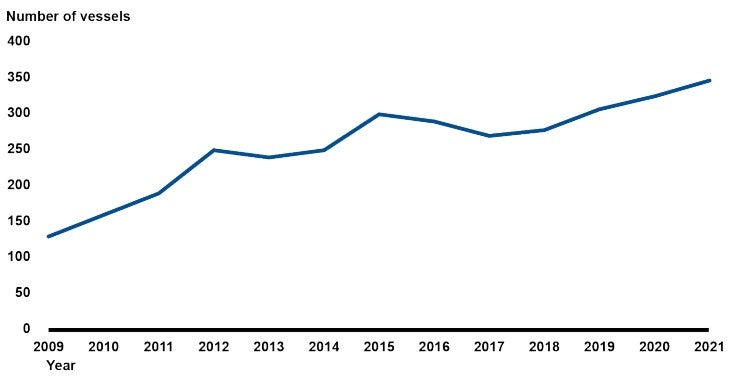The ability of the U.S. to keep pace with the upward trend of shipping to, from and through the Arctic region is a growing concern and is exacerbated by a lack of assets being deployed in the region, according to the Government Accountability Office (GAO).
“Record low levels of sea ice have made Arctic waters navigable for longer periods of time and have increased opportunities for shipping in the region,” testified Andrew Von Ah, GAO’s director of physical infrastructure, at a Wednesday hearing on Capitol Hill. “This change presents potential economic opportunities as well as safety and environmental risks, particularly given the lack of maritime infrastructure in the region.”
Von Ah’s testimony was in support of GAO’s most recent report on Arctic maritime infrastructure. The report cites data showing the number of vessels in the U.S. Arctic, including transits through the Bering Strait more than doubling between 2009 and 2021 (130-347, see chart).

Source: GAO analysis of U.S. Coast Guard data.
Economic advantages to shipping through the region will likely cause that number to grow. Trans-Arctic routes can drastically cut transit times between certain destinations, thereby reducing fuel and labor costs. For example, the route from Shanghai to northwestern Europe via the Northern Sea Route is 27% shorter than via the Suez Canal.
Most traffic in the U.S. Arctic involves transporting goods to and from the region versus shipping through it — but this also is expected to increase, particularly as the U.S. competes for energy and other natural resources extracted from the U.S. Arctic and shipped to international markets.
But GAO asserted that although diminished sea ice has prolonged the shipping season and opened up shipping routes, “environmental changes have also resulted in less predictable conditions, with more volatile weather and sea ice. The unpredictable and harsh weather and ice conditions — combined with the vast distances and lack of maritime infrastructure — pose safety risks that stretch the region’s already limited search and rescue capabilities and slow incidence response.”
Neither the White House nor the U.S. Coast Guard have included in their most recent Arctic strategies a way to measure progress in addressing maritime gaps in the region, GAO stated, including the construction of a deep-draft port, creating “harbors of refuge” in which a vessel can moor during severe conditions or when in need of repairs, and communications infrastructure.
Without the ability to measure progress as GAO has recommended in the past, the agency stated, “the results of government-wide and Coast Guard efforts cannot be demonstrated, and decision makers cannot gauge the extent of federal progress in addressing maritime infrastructure and capability gaps.”
GAO made five recommendations in two previous reports, in April 2020 and June 2016. Two of these recommendations have been implemented and three remain open. The three open recommendations are:
- The president develop a strategy for Arctic maritime infrastructure with goals and measures.
- The Coast Guard develop measures for assessing how its actions have helped to mitigate Arctic capability gaps.
- The Coast Guard design and implement a system to systematically assess progress.










